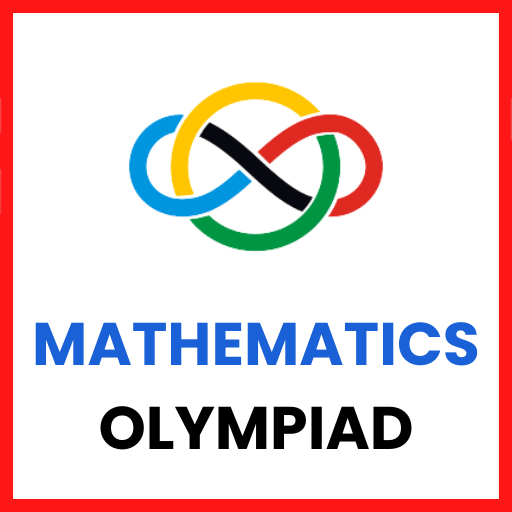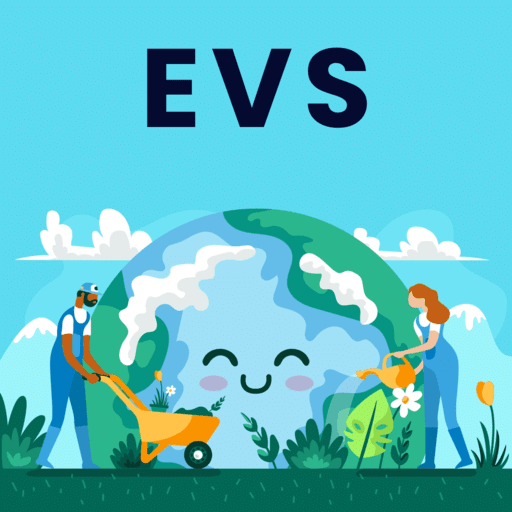Forms and Organs of Government Chapter Notes | Legal Studies for Class 11 - Humanities/Arts PDF Download
Introduction to the Organs of Government
The government is defined as a set of institutions that control through legal means and penalize lawbreakers.
The government operates by dividing functions among its organs: legislative, executive, and judicial.
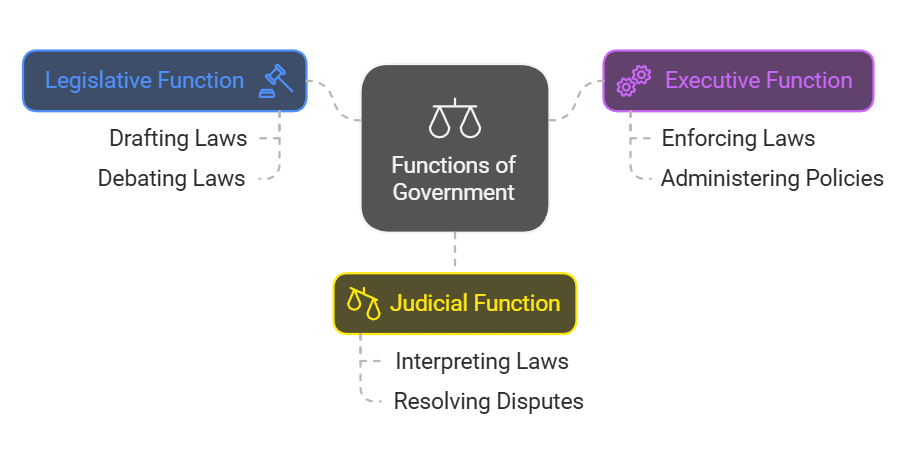
Functions of Government:
- Legislative Function: Involves making laws.
- Executive Function: Focuses on implementing laws.
- Judicial Function: Concerned with interpreting laws and settling disputes.
Separation of Powers:
- Refers to the distribution of powers among government organs.
- Legislature makes laws, the executive enforces them, and the judiciary interprets laws and resolves disputes.
Forms of Government
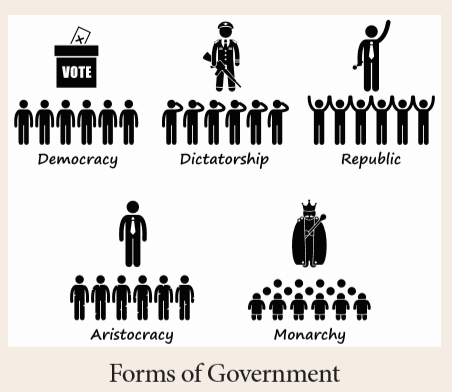
1. Monarchy
It is the oldest form of government. It involves a supreme authority in the hands of a single person wearing a crown. His authority not affected by whether the office is hereditary or elective. It is a form of government where one person's will prevails in all governance matters.
Definition by J.W. Garner:
- Any government with supreme authority in a single person is a monarchy.
- Doesn't matter if the authority is elected or hereditary.
- Not dependent on titles like emperor, king, president, etc.
- Key characteristic is one person's will governing all aspects of government.
Evolution and Decline:
- Republican and Democratic forms reduced the monarchial government.
- In some cases like the UK, monarchs are figureheads without significant political power.
- Constitutional monarchs symbolize unity but lack political influence.
2. Aristocracy
In an aristocratic form of government, political power is held in the hands of a few people.
- Origin: The term 'Aristocracy' comes from the Greek words 'aristo' meaning 'the best' and 'kratein' meaning 'to rule'.
- Characteristics:
1. Power is concentrated in a small group.
2. This group can consist of priests, soldiers, professionals, landowners, or wealthy individuals. - Garner's Definition: Aristocracy is a form of government where a small segment of citizens have a say in selecting public officials and policies.
- Selection Criteria: Those in power may be chosen based on factors like wealth, education, religious standing, family ties, or physical strength.
- Ruler vs. Ruled: The ruling class is seen as distinct and superior to the general population.
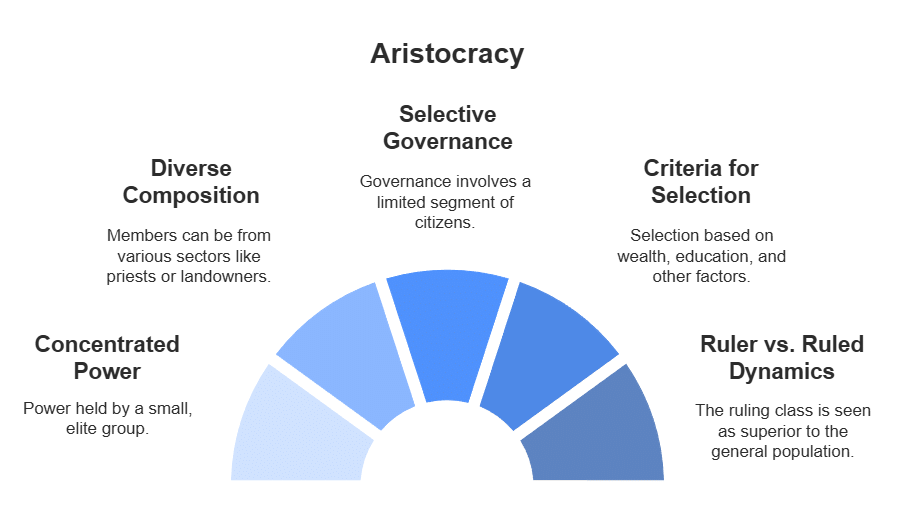
3. Dictatorship
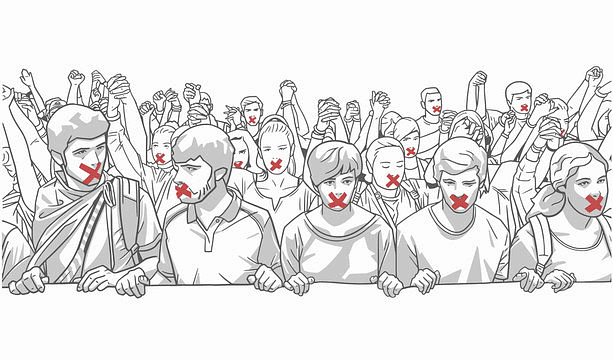
In the words of Alfred Cobban (1901-1968):
Definition: A dictatorial form of government is ruled by a single individual or a specific group who attain power through force or consent, possessing absolute and unrestricted political authority.
Characteristics:
- Political power stems solely from the dictator's will.
- Authority is exercised arbitrarily through decrees rather than laws.
- The dictator's rule is not time-bound and is immune to external oversight.
Key Points:
- The dictator enforces their commands as law and enacts judgments based on personal discretion.
- Accountability to citizens is nonexistent in this form of governance.
- Modern dictatorships often mirror totalitarian regimes.
4. Democracy
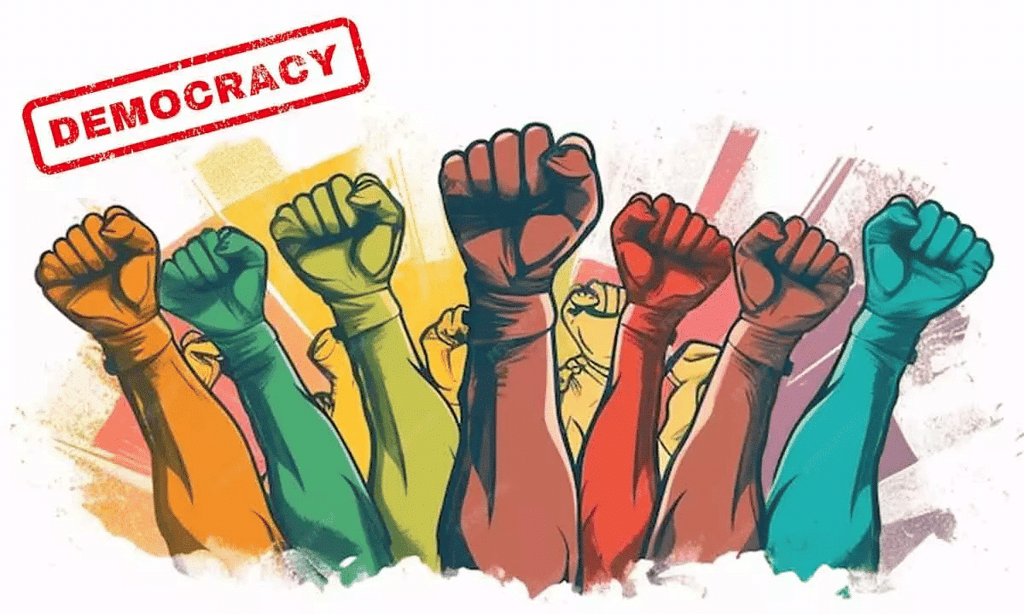
- Pericles (495-429 B.C.), a Greek leader, described democracy as a type of government where the power lies with the people.
- Bryce defined democracy as a system where the ruling power is not held by a specific class but by the entire community.
- Democracy is the most popular form of government in modern civilized states.
- The term 'democratic' comes from the Greek words 'Demos' meaning people and 'Kratia' meaning rule, indicating rule by popular vote.
- Abraham Lincoln (1809-1865), a former U.S. President, defined democracy as a government "of the people, by the people, and for the people."
- Democracy comes in two main forms: Direct (pure) and Indirect (representative).
- In a pure democracy, the will of the state is directly expressed by the people themselves, as seen in ancient Athens and Rome.
- In contemporary times, Switzerland practices aspects of pure democracy with initiatives, referendums, and plebiscites.
- Representative democracy involves citizens electing representatives who make decisions on their behalf.
- In representative democracy, the representatives are accountable to the public and form the law-making body for a specific term.
- Political power in democracy remains with the people, allowing equal participation in political affairs.
Presidential and Parliamentary Form of Government
Parliamentary System
In a parliamentary system, the legislature and executive branches are closely connected through membership and accountability.
- Examples: This system is commonly found in countries like India and the United Kingdom.
- Responsibilities: The executive, responsible for implementing laws and various functions such as health, education, defence, etc., is answerable to the legislature.
- Principle of Collective Responsibility: Ministers in parliamentary government work as a unified team, collectively accountable to the legislature for the government's actions.
- Alternative Terms: Also known as Cabinet Government (Sir Ivor Jennings) and Prime Ministerial Government (Richard Crossman).
Presidential System
In a presidential system, the executive operates independently from the legislature in terms of tenure and decision-making.
- Examples: This system is commonly seen in countries like the United States and Argentina.
- Chief Executive: The President, elected by the people for a fixed term, holds significant power over policies and actions.
- Principles: Operates on the concepts of 'separation of powers' and 'checks and balances' to distribute authority.
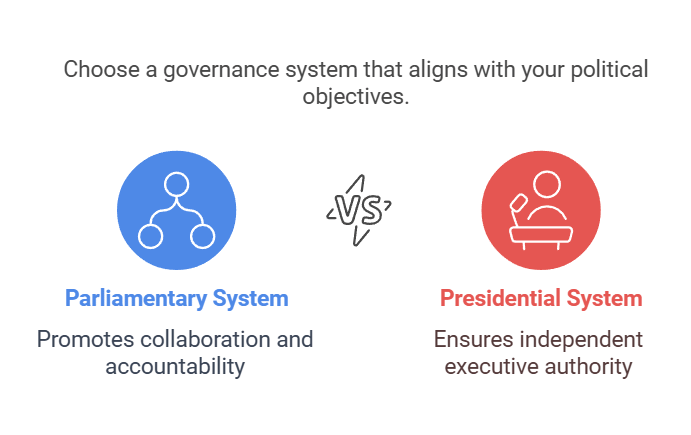
Unitary and Federal Form of Government
The unitary form of government involves organizing the entire state, including its units and provinces, under a single central government. Local/provincial governments are established by the central government as its subordinates for efficient administration.
- Characteristics:
1. No constitutional division or distribution of powers between the central government and subordinate local governments.
2. The central government delegates powers and authority to local/provincial governments. - Comparison with Federal Government: In a federal government, power is divided between the central government and individual states or territorial sub-divisions. Local/provincial governments are considered part of the central government in a unitary system.
- India's System: India's government is a Democratic Republic with a Parliamentary form that incorporates both unitary and federal features. The Constitution of India does not establish India as a federation of states but combines federal and unitary characteristics.
- Combined Forms: Many modern governments combine various forms, such as the British government combining Monarchy, Democracy, and Parliamentary forms.
 |
Download the notes
Chapter Notes: Forms and Organs of Government
|
Download as PDF |
Composition of the Legislature
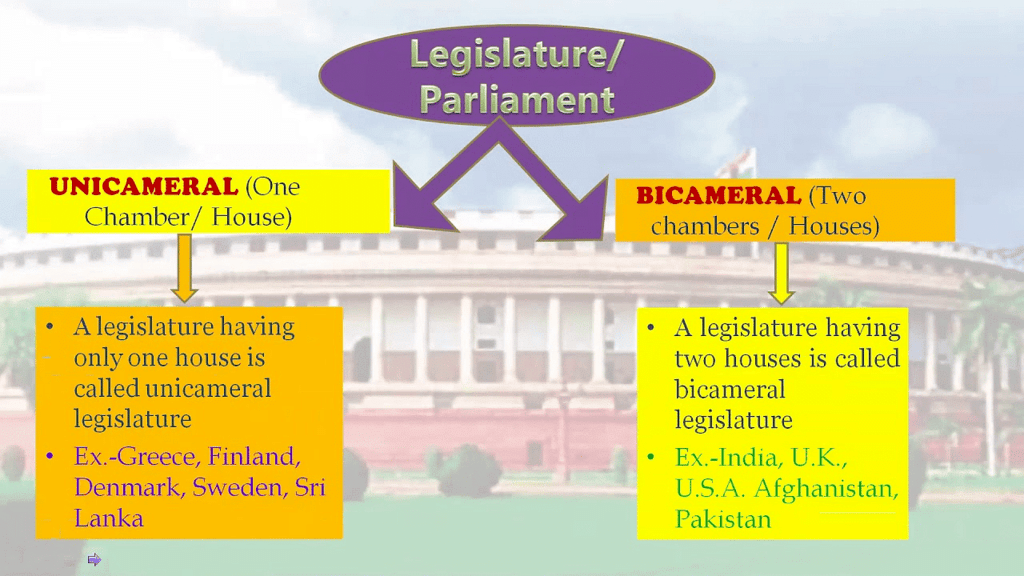
Legislature Types:
- Bicameral: Two houses or chambers.
- Unicameral: Single house.
Bicameral System in India:
1. Indian Parliament (Centre government):
- House of People (Lok Sabha): Represents citizens from all states and union territories.
- Council of States (Rajya Sabha): Represents members elected by state Legislative Assemblies and nominated experts from fields like art, culture, and science.
2. State Legislatures (State governments):
- Lower House (Vidhan Sabha)
- Upper House (Vidhan Parishad) (only in some states).
Functions of Bicameral System:
- Checks and balances by reviewing legislation carefully.
- Allows expert input to refine laws.
- Safeguards the interests of states in a federal structure.
Main Organs of Government and its Functions
There are three main organs of Government. These are:
- Legislature
- Executive
- Judiciary

A. General Functions of Legislature as Organ of Government
1. Expressing the Will of the State and Enactment of Laws- Legislature: Represents the will of the state in a democracy.
- Acts: Enacted laws that regulate institutions for specific purposes.
2. Ensuring Executive Accountability
- Article 75(3): States the collective responsibility of the Council of Ministers to the House of the People.
- Parliament: Exercises control over finances to ensure executive accountability.
3. Legislature's Judicial Functions
- Impeachment: Process for removal from office before the term ends.
- Privileges: Decided by the legislature concerning members of the house.
4. Legislature's Administrative Functions
- Electoral College: Members elect the President, Vice President, and other key positions.
- Speaker and Deputy Speaker: Elected by members of the Lok Sabha.
- Deputy Chairman of the Rajya Sabha: Elected by members of the Rajya Sabha.
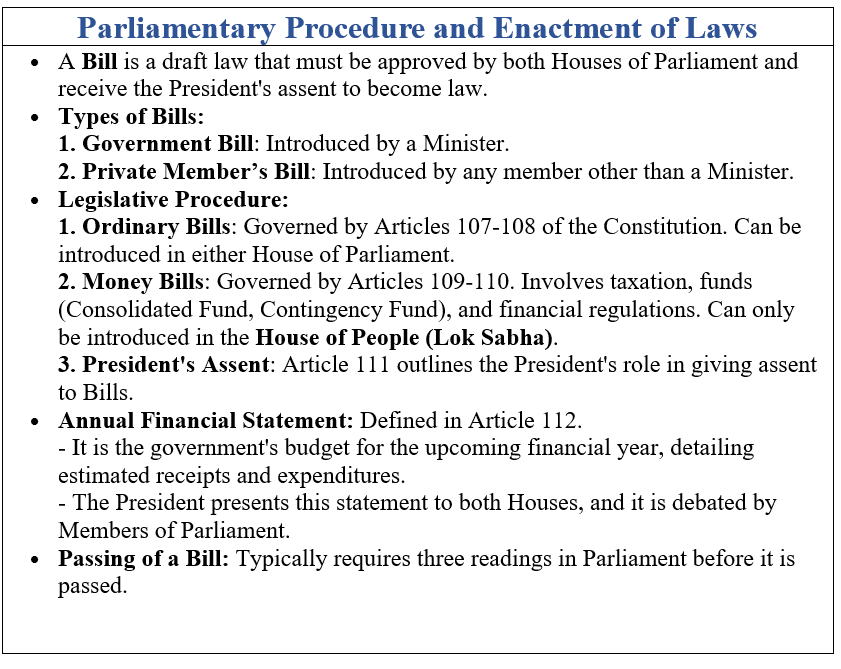 Parliamentary Procedure and Enactment of Laws
Parliamentary Procedure and Enactment of Laws
B. General Functions of Executive as Organ of Government
The executive in a state is commonly known as the 'government'. In a representative democracy, the term 'Executive' holds a broad significance.
Functions of the Executive Organ:
- Internal and External Administration of the State: The primary role of the executive involves managing internal and external affairs such as law enforcement, finances, infrastructure development, welfare programs, environmental conservation, trade, defense, and foreign relations.
- Executive and its Legislative functions: The executive also carries out certain legislative functions through Delegated Legislation, which involves creating detailed laws under the authority granted by the Parliament.
- Ordinance: An ordinance is a law issued by the President in India when Parliament is not in session. It allows for immediate legislative action but needs parliamentary approval within six weeks.
- Executive and its financial functions: The executive manages tax collection, government spending, budgeting, accounting, and formulating financial policies, including securing grants from international institutions like the IMF and World Bank.
- Executive and Judicial functions: Judicial functions of the executive include the power to grant pardons, commute sentences, and make certain legal decisions based on special circumstances.
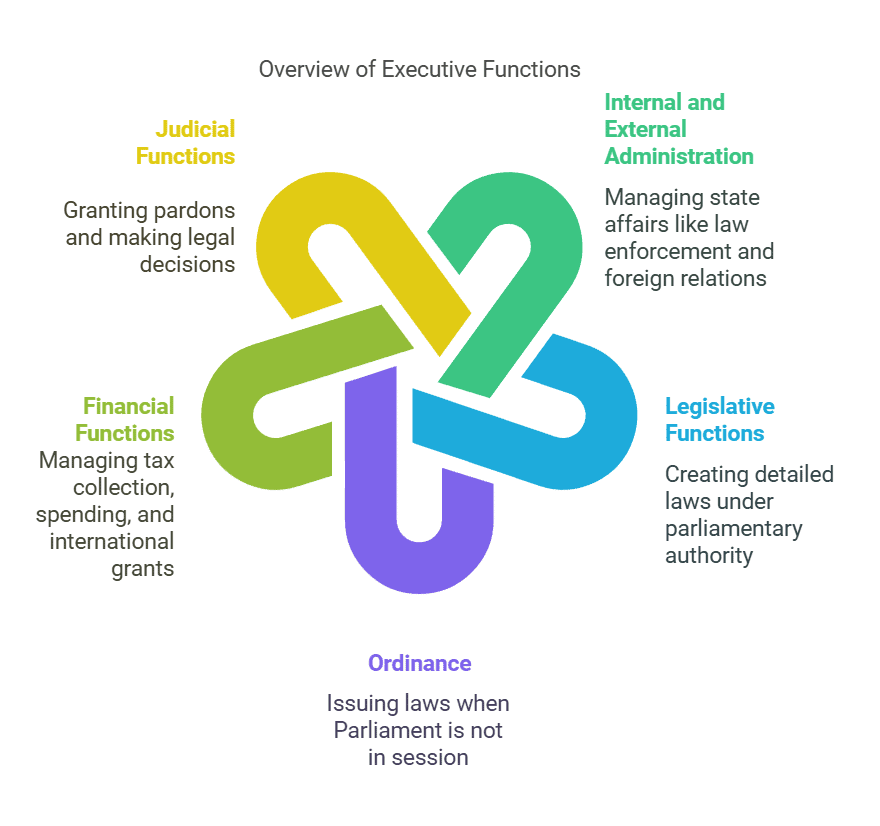
C. General Functions of Judiciary as Organ of Government
- To Hear and Decide disputes: The primary function of the judiciary is to resolve disputes between individuals, the state, and various entities, ensuring impartial and timely justice delivery.
- Judicial Review: Judicial review empowers the judiciary to assess legislative and executive actions for compliance with the constitution, nullifying those that violate constitutional provisions.
- Interpretation of laws: When laws are unclear or conflicting, courts interpret their meaning and intent to ensure consistency and understanding.
- Advisor to the President: The Supreme Court offers advisory opinions to the President on matters referred under Article 143 of the Constitution.
- Role of Judiciary as an activist: Post-Emergency in India, the judiciary took an activist stance, introducing public-interest litigation (PIL) to promote justice for marginalized groups.
- Legislative and executive function of the judiciary: The judiciary formulates and enforces rules to manage its functions independently, ensuring efficient administration.
 Judiciary and its Jurisdiction
Judiciary and its Jurisdiction
Conclusion
The forms and organs of government—Legislature, Executive, and Judiciary—work together to ensure a balanced system of governance through the Separation of Powers. The Legislature creates laws, the Executive enforces them, and the Judiciary interprets and adjudicates disputes. This structure, along with specialized bodies like tribunals and forums, ensures laws are crafted, implemented, and upheld efficiently, maintaining checks and balances within a democratic framework.
|
69 videos|76 docs|25 tests
|
FAQs on Forms and Organs of Government Chapter Notes - Legal Studies for Class 11 - Humanities/Arts
| 1. What are the main differences between Presidential and Parliamentary forms of government? |  |
| 2. What is the distinction between Unitary and Federal forms of government? |  |
| 3. What is the composition of the legislature in a typical government system? |  |
| 4. What are the general functions of the executive as an organ of government? |  |
| 5. What role does the judiciary play as an organ of government? |  |






